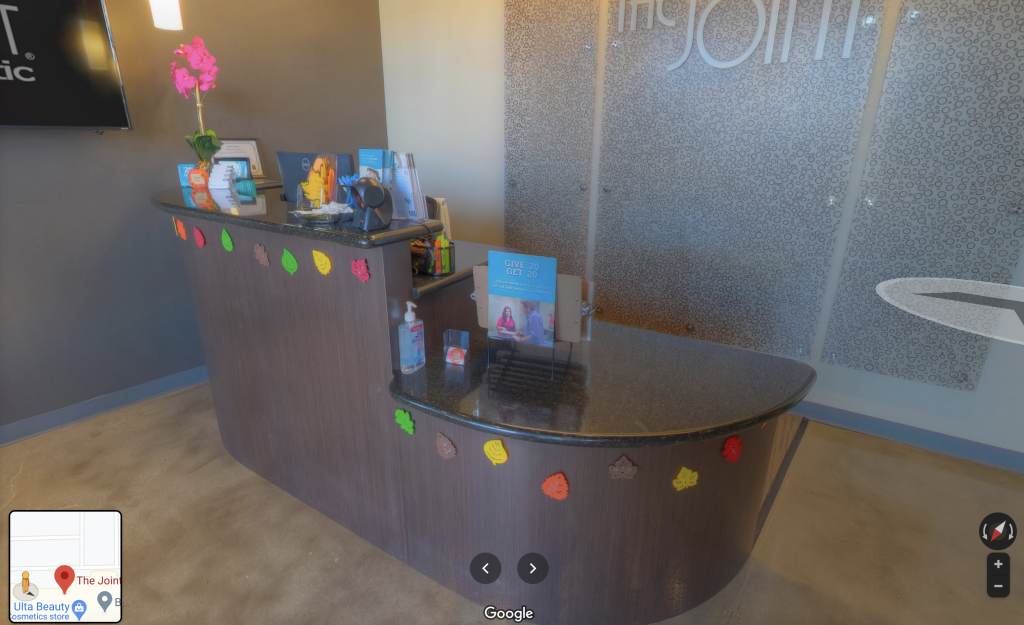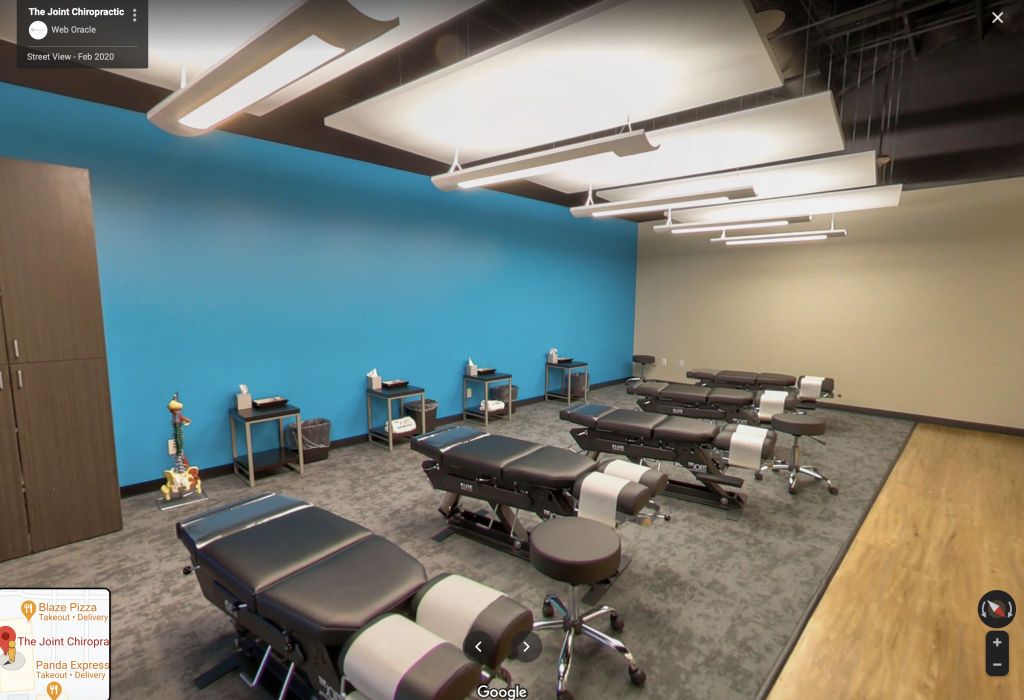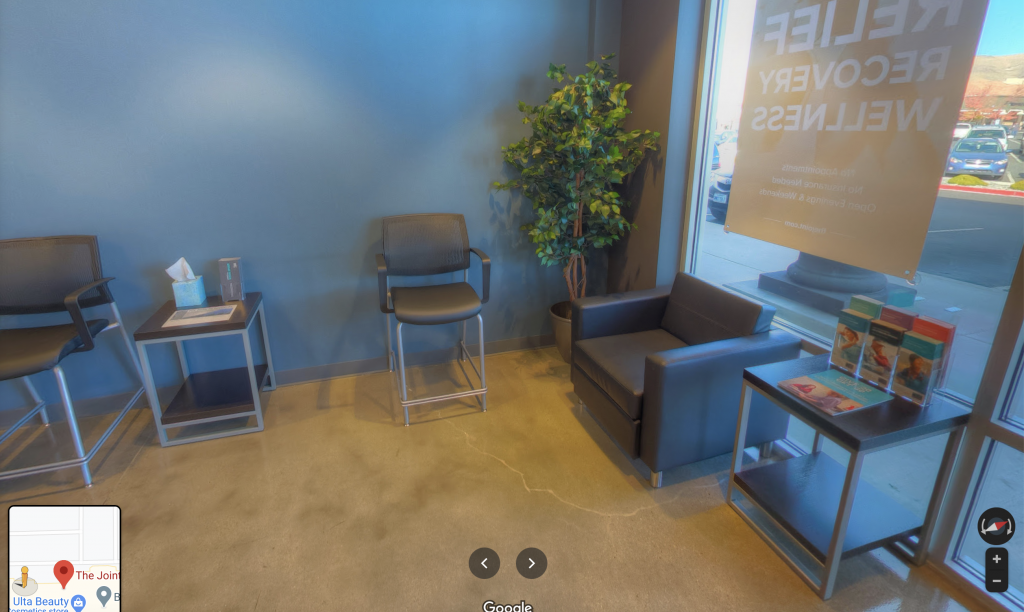How The Joint has put a polish on a chiropractic clinic.
When you look at your typical chiropractic clinic in your town, you’ll see a mixed bag of techniques and practice styles. I think this is bad for the continuity of care for patients. I’d like to see more reliable expectations for patients–they should know what they are getting into when they go to a chiropractor.
But even worse, in this industry, is that mom and pop chiropractic offices are a visual mess. No planned aesthetic to the office look and feel.
This morning, I browsed through the Internet, down The Joint’s rabbit hole, with a twinge of nostalgia over my experience helping a business owner start up his The Joint clinic. This was back in 2012.
Before that, though, my first experience with The joint franchise was seeing one go up in Berkeley. Back in the day, after The Joint sold to the Massage Envy guy, the Berkeley clinic was part of a scattered few clinics that were known as “legacy clinics.” Legacy clinics could do what they wanted, as far as office decor, layout, and probably business practices. In my mind, I’m picturing that Berkeley clinic, and how it is a nice open space, but it’s different and confusing compared to the standard Joint clinic.

I enjoy the simple simplicity of a The Joint clinic. Now, when you find one, it’s going to have the same layout and the same business practices. Curiously, you’ll have a different fee schedule depending on where you are in the United States.
The Outside.
To paint the setting, let’s start in the retail environment where the clinic is located. High traffic. Plenty of parking. The Joint clinics are usually next to a Starbucks, or a Whole Foods, or some other high-end but high volume franchises. These are the same retail areas where you might find an Orange Theory or Daily Method. This retail environment securely meets the desired demographics of a 40 year old mother of 2, who drives a luxury SUV, and loves to work out in a trendy health club, and go for a $7 Joe and the Juice afterward. These are health-conscious people with money to spend on wellness-focused care, and not just pain relief. Nevertheless, they have neck pain and headaches from spending time on Facebook complaining to companies about their poor customer service.
The clinic has a massive sign over the door. It’s back lit, or channel lit, or some term like that. I don’t know signs. And I think the sign is probably one of the biggest expense involved in clinic buildout. The sign, when placed well, and when done in a quality way, really builds clinic credibility and esteem.



I’ve learned back in those days that visibility is oxygen to a business. If people can’t see you, that’s a great way to go out of business. The Joint always chooses a high-visibility spot with lot’s of parking, and lots of other franchised businesses that follow a formula.
The Inside.
Inside the clinic is more formula. Painted concrete floors. Exposed dark-colored open ceilings. Contemporary colors. Clean and pleasing to the eye. Trouble is, they are still using that Ikea looking furniture that they’ve been using for 10 years. The front desk is a custom built looking desk that is made to fit the floor plan of the clinic, but it’s using the same kind of laminate covering. There’s no intrusive shielded medical clinic style glass between the patient and the wellness coordinator. It’s open. It’s also designed for the wellness coordinator to stand up to greet the patient, and come out from behind the desk to warmly greet them. Pre-2020, at least.



I realize my picture captions are a little cynical, but I really do like the clean look of these clinics. Open. Airy. Welcoming. Nothing scary to shock you. Let’s take a look at the typical chiropractic clinic where some mom and pop has been working there for 30 years. Cluttered! I don’t want to screenshot someone else’s private clinic because it’s someone’s baby. But I’ve seen some lived-in clinics. Some people have too many toys, and nowhere to organize them.
And if you’re a patient at one of these clinics, you might become use to the way it looks, and you forgive and forget. But to a new patient, the first impression can be a bad one. Ben Altadonna talks about this when he talks about some of his client’s clinics. Dirty windows. worn out carpet. He will give you a checklist of things to look for, all the way up to the way the doctor is dressed. Hint: buy some nicer shoes.
The Marketing.
A nationwide franchise means that all of the clinics pay a 7% fee, and they can all pool together to hire a marketing agency to produce some top-notch ads. Their marking campaign, where they say “You’re/Your back, Baby.” is a beautiful campaign.
Simple, consistent message. All pointing back to your local The Joint clinic. beautifully demonstrating what chiropractic care can do for your healthy lifestyle. Except since you never know what kind of chiropractor you will encounter when you throw a dart at the map and choose a mom & pop chiropractor, you’re going to want to choose a franchised chiropractor who follows the formula. Just give me some chiropractic so I can swing a golf club again!
Prior to the “Todd’s Back, Baby” campaign, The Joint did some videos that emulated the “What’s the Big Idea” patient education video from 15 years ago. They did their own copy of it with a spokesman walking through an infinite white backdrop with high-key lighting, affably explaining what chiropractic care is all about. “Subluxation!? WTF is that? Are you sure?”
But being a nationwide franchise, they bumped up the quality of the production and simplified the message, like in this video of Kamala Harris trying to plug in her laptop while suffering from back pain. Well done.
The Pricing.
Go to any online chiropractic forum, and the first thing you’ll learn is that The Joint is cheapening the profession. The prices are too low. From a free initial adjustment, to the $19 first visit, to the $49 monthly fee. They undervalue care. Now that it’s 2021, the prices are still free, then $29, then $79 for a month.
I would say that $79 is a little bit more inline with the ultra-simple care that they provide. No modalities. No massage. No time for exercise demonstrations and counseling, of course. The monthly fee is less of a problem in my eyes.
From my perspective, the entire franchise could elevate the value of care by pricing the first visit a little more inline with the expertise that their doctors provide. You have to do an exam on a new patient in order to rule out red flags and differential diagnoses. This is portal of entry health care, and they should charge accordingly. They have a beautiful space to provide contemporary chiropractic care, they can get away with a more premium price. Starbucks doesn’t give away $0.49 cups of coffee, but The Joint is doing the equivalent.
What they could do is meet the first visit fee with the same $79 that they charge for their membership. And to help promote the membership, they could waive the fee, and just use that first visit as part of their routine membership fee.
I wonder what kind of discussions management had around the executive table when discussing pricing? I bet they are still revisiting the idea; at least I hope so.
I admit it. One of the things about The Joint that gets me nostalgic about the simple clinic model is that they don’t bill insurance. Straightforward out of pocket pay, baby. There’s no waiting 8 weeks for a claim payment or denial. There’s no gnashing your teeth over applying payments to the proper codes. You adjust. You collect your $29, and you move on. Every morning you open the clinic doors to start the day, and you review how many membership fees came in that morning. You know you can pay rent the next month because the membership fees are so predictable. It’s nice.
And package sales are icing on the cake, from a business perspective. Sell a package of 20 visits for $429, and that allows you to have a nice bump of income for the month. It makes a difference. Their software, I’m sure, has a foolproof way to track the visits used, and a routine visit only takes a few minutes of the doctor’s time. Jot down what you did in the records, and move on.
The Business.

A membership-based business is a great way to build loyalty, as people become part of the tribe. People build a weird loyalty to your brand when they pay you money every month. Apple plus, Netflix, and Amazon Prime have taught all of us that we can have pride in belonging to a corporate club. And we like it that way.
And chiropractic care feels great. You get cracked, and you leave feeling lighter, and like there’s less pressure. For $79 a month, it’s a great value.
As you see from my quick and dirty spreadsheet, the business starts out slow, and builds and builds. I ignored attrition, where people cancel and drop out of care, of course, and I was also pretty optimistic with the growth, but that’s because I didn’t want to spend an hour on it.
Dig this: At $79 a member you get:
100 members is $7900 a month, recurring.
200 members is $15,800 a month, recurring.
300 members is $23,700 a month, recurring.
And then you add packages income and the little bit of income form people paying out of pocket. Not that bad considering you aren’t filling out insurance forms and waiting around for checks.
300 people visiting you a weeks is pretty busy, but it’s all uncomplicated care. A quick adjustment. And pretty soon you have people who make a routing of seeing you every Thursday afternoon because it’s their time.
Contrast this with the ultra-loyal Medicare patient who also makes it a routing of seeing you every Thursday afternoon. you have to document, then bill, then appeal denials, and sit at your desk and hope to get paid. I’m sure if its all you did, single payer style, you would get use to it and get into the flow. But it was never that easy for me. More trouble than it’s worth.
Consider that at the high end, clinic rent might be $4000, and you pay your front desk staff $5000, and you pay yourself $10,000. You’re going to need to get up to 300 members as fast as you can. But is your clinic rent is a more modest $2000, and you don’t have staff, your overhead and pay is $15,000, and that’s an easier 200 members. You might need to have some support staff to get to that point, though.
But seeing 200 people 4X every month with no billing and minimal paperwork is a pretty cushy job. Show up. Adjust. Tell some jokes, and dream some dreams. Go home. Maybe set a cap on 200, and gradually raise the monthly fee as a waiting list forms outside your tribe to join. Not a bad idea for a simpler way of life.
Could you start your own franchise?
I couldn’t imagine paying $39,000 just to sign up. Pay them a monthly fee for software. Pay them a monthly fee to pay the radio service to play smooth jazz all day. Probably pay them a monthly advertising fee. And, on top of all that, pay them a recurring 7% of everything you take in as a franchise fee. Then, be forced to go to their training in Scottsdale for more cash out of your pocket.
No wonder they tell you that you have to have a net worth of $500,000 to become a franchisee!
There’s the old joke: How do you make a small fortune as a The Joint franchisee? Answer: Start with a large fortune.
Meanwhile, as a licensed chiropractor, all I have to do is find four walls, get a municipal business license, find a bench to lay people on, and collect money for myself. Sure, most will cut corners by having their brother design their layout, but at least you aren’t paying a premium for Ikea furniture and some home-made software.
Besides. I own my own shockwave machine, and I intend to use it on those patients who need it. I’m going to design my own clinic, and run it how I envision it. Patient centered, but on my own platform.
Responses